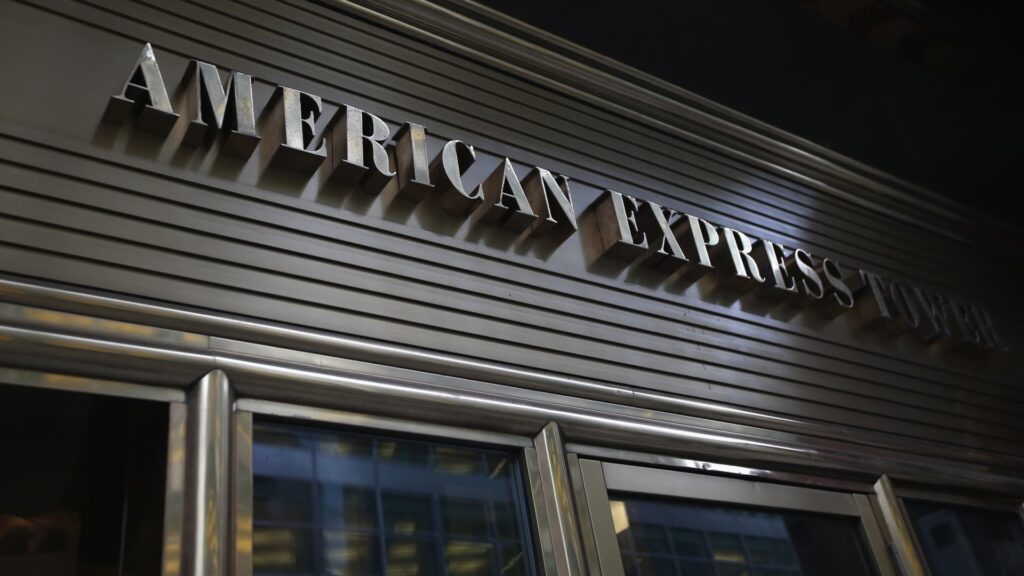
American Express Consumer Spending Trends Defy Trump Tariff Concerns
American Express Consumer Spending Trends Defy Trump Tariff Concerns
American Express reports resilient consumer spending despite economic uncertainties around Trump tariff policies
Despite growing economic concerns surrounding President Trump’s tariff policies, American Express consumer spending trends show remarkable resilience among its affluent cardholders. According to Chief Financial Officer Christophe Le Caillec, the company’s first-quarter transaction volumes demonstrate continued confidence among its customer base, with particularly strong growth driven by younger cardmembers.
Table of Contents
- American Express Q1 Performance: Growth Despite Economic Headwinds
- Demographic Analysis: Generational Differences in Spending Habits
- Restaurant Spending as a Key Economic Confidence Indicator
- Airline Transaction Slowdown: Travel Sector Challenges
- Navigating Trump Tariff Policies: Potential Impact on Consumer Behavior
- American Express Market Position Compared to Other Credit Card Issuers
- Future Outlook: Maintaining Guidance Despite Uncertainties
- Frequently Asked Questions About American Express Consumer Spending
American Express Q1 Performance: Growth Despite Economic Headwinds
The latest American Express consumer spending trends revealed in the company’s Q1 2025 earnings report show a 6% increase in billed business on AmEx cards, or 7% when adjusted for the leap year effect. This growth trajectory continues the positive momentum observed in late 2024, indicating that affluent consumers remain largely unfazed by broader economic concerns.
“There’s a lot of stability and strength, despite the news and the environment,” Le Caillec told CNBC, highlighting the company’s ability to maintain robust transaction volumes even as markets experienced significant volatility. What makes this performance particularly noteworthy is that these positive American Express consumer spending trends have persisted into April, despite sharp declines in stock markets this month amid growing concerns about President Donald Trump’s tariff policies potentially triggering a recession.
The company’s Q1 results exceeded profit expectations, further demonstrating that American Express’s premium customer base may serve as an effective buffer against economic uncertainties linked to tariff concerns and persistent inflation challenges. This resilience stands in stark contrast to other credit card issuers targeting different market segments, such as Synchrony Financial, which has recently warned of a spending slowdown among its customer base.
Key American Express Q1 2025 Performance Metrics
- Billed business on AmEx cards: 6% growth (7% when adjusted for leap year)
- Transaction volume from millennial and Gen Z cardholders: 14% increase
- Restaurant spending: 8% growth (strong discretionary spending indicator)
- Airline transactions: 3% growth (4% adjusted for leap year), down from 13% in Q4 2024
- Maintained full-year guidance: 8-10% revenue growth, $15-$15.50 earnings per share
Demographic Analysis: Generational Differences in Spending Habits
A fascinating insight from the latest American Express consumer spending trends is the significant variation in spending behaviors across different age demographics. The company reported that millennial and Gen Z cardholders increased their spending by an impressive 14% during the first quarter of 2025, demonstrating robust confidence in their financial situations despite broader economic uncertainties.
In contrast, older cardmembers showed considerably more restraint in their spending patterns. Gen X consumers registered a more modest 5% increase in transaction volumes, while Baby Boomers were the most conservative, with just a 1% uptick in spending. This generational divide in the American Express consumer spending trends reveals important differences in how various age cohorts perceive and respond to current economic conditions and policy uncertainties.
The higher spending growth among younger cardholders could reflect several factors, including potentially lower exposure to market volatility through retirement investments, different consumption priorities, or a greater willingness to maintain lifestyle spending despite economic headwinds. It may also indicate that younger consumers have not yet experienced significant negative impacts from the tariff policies and are continuing their spending habits without substantial adjustments.

Millennial and Gen Z American Express cardholders drove significant spending growth in Q1 2025, increasing transactions by 14%
Restaurant Spending as a Key Economic Confidence Indicator
Among the various spending categories analyzed in the American Express consumer spending trends report, restaurant transactions have emerged as a particularly significant indicator of consumer confidence. Le Caillec specifically highlighted the 8% increase in restaurant spending as a compelling sign of ongoing economic resilience among the company’s cardmember base.
“Restaurant spend is up 8%,” the CFO noted. “This is the ultimate discretionary expense, it’s not something you can bring forward, and so it’s really a good indicator of the strength of our cardmember base and the confidence they have.” This observation carries substantial weight in economic analysis because dining out represents purely discretionary spending that cannot be attributed to inventory building or forward purchasing behaviors that might artificially inflate other retail categories.
The strong growth in restaurant transactions within the American Express consumer spending trends data provides evidence that affluent consumers remain willing to allocate significant resources to non-essential experiences, suggesting they maintain positive outlooks on their personal financial situations despite the broader economic uncertainties. This continued confidence in discretionary spending could indicate that American Express’s premium customer segment perceives the current economic headwinds as temporary or believes they are sufficiently insulated from potential negative impacts.
Pro Tip: Restaurant Spending as an Economic Barometer
When analyzing American Express consumer spending trends, pay special attention to restaurant transaction growth as a reliable indicator of true discretionary spending confidence. Unlike retail purchases that might be accelerated due to tariff concerns, dining expenses represent real-time consumer sentiment that can’t be “pulled forward” and typically signal genuine economic confidence among affluent consumers.
Airline Transaction Slowdown: Travel Sector Challenges
Despite the generally positive American Express consumer spending trends, the company’s earnings presentation revealed a notable weakness in the travel sector, particularly in airline transactions. This category showed just 3% growth (4% when adjusted for the leap year), a significant deceleration from the robust 13% growth recorded in the fourth quarter of 2024.
This slowdown in airline spending stands out as an area of potential concern within the otherwise strong transaction data. The travel industry has traditionally been a significant component of American Express’s premium cardholder spending, with the company’s various travel rewards and benefits designed to incentivize flight bookings and related expenses.
The marked deceleration in airline transaction growth could reflect several factors: heightened concerns about international travel given global economic uncertainties, potential impacts of tariff-related business travel reductions, or a recalibration after particularly strong holiday season bookings. For investors tracking American Express consumer spending trends, this travel sector weakness bears monitoring as a potential early indicator of changing sentiment among affluent consumers regarding higher-value discretionary purchases.
Important Note on Travel Sector Performance
The slowdown in airline transaction growth (from 13% in Q4 2024 to just 3-4% in Q1 2025) represents one of the few weakness indicators in the latest American Express consumer spending trends report. This travel sector deceleration may warrant closer attention as a potential early warning sign of changing consumer behavior in high-value discretionary categories.
Navigating Trump Tariff Policies: Potential Impact on Consumer Behavior
A central question surrounding current American Express consumer spending trends is whether consumers are adjusting their purchasing behaviors in response to President Trump’s tariff policies. Le Caillec acknowledged the complexity of this analysis, noting that it’s challenging to determine whether cardholders are accelerating purchases to avoid potential price increases resulting from future tariffs.
JPMorgan executives recently suggested that some transaction volume growth might represent “pulled forward” purchases, where consumers and businesses are accelerating buying decisions before tariff-related price increases take effect. Le Caillec indicated that while this phenomenon is difficult to quantify precisely in the American Express consumer spending trends data, there are indications that some small businesses may indeed be building inventory due to concerns about tariff-driven cost increases.
This potential distortion in spending patterns introduces an important consideration for analysts interpreting current transaction volumes. If a significant portion of current spending represents accelerated purchases rather than sustainable consumption patterns, future quarters could see compensatory declines once inventory building is complete. However, the continued strength in categories like restaurant spending—which cannot be “pulled forward”—suggests that at least some of the robust American Express consumer spending trends reflect genuine consumer confidence rather than merely anticipatory purchasing.
American Express Market Position Compared to Other Credit Card Issuers
The resilience demonstrated in American Express consumer spending trends highlights an important distinction between the company’s market position and that of other credit card issuers targeting different customer segments. While American Express continues to report strong transaction volumes, Synchrony Financial, which specializes in store cards for popular retailers across a broader consumer spectrum, has recently warned of a spending slowdown.
This divergence underscores how American Express’s focus on affluent consumers may provide a degree of insulation from economic pressures affecting the broader market. Wealthy cardholders typically have greater financial reserves, more stable income sources, and less sensitivity to short-term economic fluctuations, allowing them to maintain spending patterns even during periods of uncertainty.
The contrast between these American Express consumer spending trends and the cautionary signals from issuers serving other market segments suggests that the current economic environment may be creating a bifurcated consumption landscape. While premium cardholders continue relatively unaffected, particularly in discretionary categories like dining, consumers in other income brackets may already be adjusting their spending in response to concerns about inflation and potential tariff impacts.
| Credit Card Issuer | Target Customer Segment | Current Transaction Trends | Guidance Outlook |
|---|---|---|---|
| American Express | Affluent consumers, premium market | Strong growth (6-7% overall, 14% among younger users) | Maintaining guidance despite uncertainties |
| Synchrony Financial | Mass market, store card users | Warning of spending slowdown | Cautious outlook due to inflation pressures |
| JPMorgan Chase | Broad market coverage | Noting potential “pulled forward” purchasing | Highlighting uncertainty around tariff impacts |
Future Outlook: Maintaining Guidance Despite Uncertainties
Despite the economic uncertainties surrounding tariff policies, the American Express consumer spending trends have given management sufficient confidence to maintain their financial guidance for 2025. The company continues to project revenue growth of 8% to 10% and earnings of $15 to $15.50 per share for the full year.
This steady outlook stands in contrast to many other corporations that have pulled or adjusted their earnings guidance due to tariff-related uncertainties. Le Caillec’s decision to maintain the company’s projections signals a belief that the current American Express consumer spending trends reflect sustainable patterns rather than temporary distortions that might reverse in coming quarters.
However, the company has added a noteworthy caveat to its guidance, specifically indicating that projections are “Subject to the Macroeconomic Environment.” This qualification acknowledges the potential impact of changing economic conditions while still expressing confidence in the company’s ability to navigate the current landscape based on observed consumer behaviors.
For investors and analysts tracking American Express consumer spending trends, this maintained guidance with added caution suggests a balanced outlook: confidence in the resilience of premium cardholders’ spending habits, tempered by pragmatic recognition of the unpredictable nature of current economic policy developments.
Frequently Asked Questions About American Express Consumer Spending
How much did American Express card spending grow in Q1 2025?
According to the latest American Express consumer spending trends report, billed business on AmEx cards increased by 6% in Q1 2025, or 7% when adjusted for the impact of the leap year.
Which age groups are driving American Express spending growth?
Millennial and Gen Z cardholders are the primary growth drivers in American Express consumer spending trends, with a 14% increase in transaction volumes during Q1 2025, compared to more modest growth from Gen X (5%) and Baby Boomers (1%).
Has American Express maintained its financial guidance for 2025?
Yes, despite economic uncertainties related to tariff policies, American Express has maintained its 2025 guidance of 8-10% revenue growth and earnings of $15-$15.50 per share, though it added the caveat “Subject to the Macroeconomic Environment.”
What spending category does American Express consider the best indicator of consumer confidence?
Restaurant spending, which increased 8% in Q1 2025, is highlighted in American Express consumer spending trends analysis as a key indicator of genuine consumer confidence because it represents purely discretionary spending that cannot be “pulled forward.”
Are American Express customers changing spending patterns due to tariff concerns?
While some small business customers may be building inventory in anticipation of tariff-related price increases, overall American Express consumer spending trends show limited evidence of widespread behavior changes among affluent consumers in response to tariff policies.
How do American Express spending trends compare to other credit card issuers?
American Express reports continued strong spending among its affluent customer base, while other issuers like Synchrony Financial (which serves a broader market segment) have warned of spending slowdowns, suggesting a bifurcated consumer response to current economic conditions.
Which spending category showed weakness in the latest American Express report?
Airline transactions showed a marked slowdown in the American Express consumer spending trends report, growing just 3% (4% adjusted for leap year) in Q1 2025, compared to 13% growth in Q4 2024.
What does American Express CFO Christophe Le Caillec say about current consumer confidence?
“There’s a lot of stability and strength, despite the news and the environment,” indicating that American Express consumer spending trends reflect continued confidence among the company’s cardmember base despite broader economic uncertainties.
Key Takeaways on American Express Consumer Spending Trends
- American Express consumer spending trends show remarkable resilience despite market volatility and recession concerns related to Trump tariff policies
- Younger cardholders (millennial and Gen Z) are driving growth with a 14% spending increase, while older generations demonstrate more caution
- 8% growth in restaurant spending serves as a key indicator of genuine consumer confidence, as dining represents purely discretionary spending that cannot be accelerated
- Airline transaction growth has slowed significantly to 3-4%, down from 13% in Q4 2024, representing a potential area of weakness
- American Express has maintained its full-year guidance despite economic uncertainties, projecting 8-10% revenue growth and $15-$15.50 earnings per share
- The company’s premium cardholder base appears to be insulated from spending pressures affecting other market segments
- Some small businesses may be accelerating purchases to build inventory before potential tariff-related price increases
The latest American Express consumer spending trends provide valuable insights into the behavior of affluent consumers during a period of economic uncertainty. Despite growing concerns about President Trump’s tariff policies and their potential impact on the broader economy, American Express cardholders—particularly younger members—continue to demonstrate strong confidence through their transaction patterns.
With restaurant spending showing robust 8% growth and overall billed business increasing by 6-7%, the data suggests that premium consumers remain largely unfazed by current market volatility. However, the noticeable slowdown in airline transactions and the cautionary behavior of older cardholders indicate that certain segments may be adopting a more measured approach to spending.
As American Express maintains its financial guidance while acknowledging macroeconomic uncertainties, these American Express consumer spending trends will continue to serve as an important barometer for understanding how affluent consumers navigate an increasingly complex economic landscape in 2025.
Published on April 18, 2025 | Last Updated: April 18, 2025






